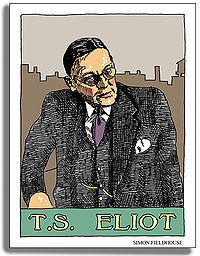- The Criterion (magazine)
-
The Criterion was a British literary magazine published from October 1922 to January 1939.[1] The Criterion (or the Criterion) was, for most of its run, a quarterly journal, although for a period in 1927-28 it was published monthly. It was created by the poet, dramatist, and literary critic T. S. Eliot who served as its editor for its entire run.
Eliot's goal was to make it a literary review dedicated to the maintenance of standards and the reunification of a European intellectual community.[2] Although in a letter to a friend in 1935 George Orwell had said "for pure snootiness it beats anything I have ever seen",[3] writing in 1944 he referred to it as "possibly the best literary paper we have ever had".[4] The first issue of the magazine, of which 600 copies were printed,[5] included Eliot's The Waste Land. In its first year, it received contributions from Luigi Pirandello, Virginia Woolf, Ezra Pound, E. M. Forster, and W. B. Yeats.[6] Other contributors over the years included Wyndham Lewis, Ezra Pound, Herbert Read, John Middleton Murry, John Gould Fletcher, W. H. Auden, Stephen Spender, and Hart Crane. Nine contributions in 1924 and 1925 were made, pseudonymously, by Eliot's first wife, Vivienne Haigh-Wood,[7] who suggested the journal's name.[8] The Criterion became the first English periodical to publish Marcel Proust, Paul Valéry and Jean Cocteau.[6][9]
Lady Rothermere (Mary Lilian Share, the wife of the London newspaper magnate Harold Harmsworth, Viscount Rothermere) originally financed the journal, but on reading the first issue, she wrote three letters to Eliot criticizing it, and suggested ideas for later issues, including a story by Katherine Mansfield.[5] After four years she withdrew her support and the magazine was acquired by Eliot's employer, Faber and Gwyer Publishing (later Faber & Faber). From January 1926, when Faber became the publisher, though January 1927 the journal was titled The New Criterion. The issues from May 1927 though March 1928 were titled The Monthly Criterion.[10]
Some of Eliot's other contributions include his short story "On the Eve", commentaries, and poems, including early versions of "The Hollow Men" and "Ash Wednesday".
Together with its rival, Adelphi, edited by John Middleton Murry, it was the leading literary journal of the period. While the former's definitions of literature were based on romanticism allied to liberalism and a subjective approach, Eliot used his publication for expounding his defense of classicism, tradition, and Catholicism.[6] In this contest Eliot emerged a clear victor, in the sense that in the London of the 1930s he had taken the centre of the critical stage.[11]
References
- ^ http://www.jstor.org/pss/1768640 T. S. Eliot's Criterion: The Editor and His Contributors, by Herbert Howarth (1950)
- ^ http://app.cul.columbia.edu:8080/ac/handle/10022/AC:P:1009 Academic Commons Columbia University Libraries
- ^ "An Age Like This" (1936) (The Collected Essays, Journalism and Letters of George Orwell Volume 1 - An Age Like This 1939-1940 p.197 (Penguin) )
- ^ "As I Please" (1944) (The Collected Essays, Journalism and Letters of George Orwell Volume 3 - As I Please 1943-1945 p.197 (Penguin) )
- ^ a b [1] "Anything I Write Is Good: Letters of T.S. Eliot" The New York Times
- ^ a b c Sabloff, Nicholas. "The Nursery of Genius: A brief survey of ten magazines of influence" http://www.nyrm.org/2007/sabloff_well.html
- ^ Gallup, Donald. T. S. Eliot: A Bibliography (A Revised and Extended Edition) p. 211 (Harcourt Brace & World 1969)
- ^ Ackroyd, Peter (1984). T. S. Eliot. New York: Simon & Schuster. p. 123. ISBN 0671530437.
- ^ Ackroyd, p. 248
- ^ Gallup, p.14
- ^ David Goldie, A Critical Difference: T.S. Eliot and John Middleton Murry in English Literary Criticism, 1919-1928 (1998), pp. 2-3.
T. S. Eliot People - E. Martin Browne
- Valerie Eliot
- Vivienne Haigh-Wood Eliot
- Ezra Pound
- Jean Jules Verdenal
- William Butler Yeats

Early poems - Ariel Poems
- ("The Journey of the Magi")
- "Gerontion"
- "The Hollow Men"
- "The Love Song of J. Alfred Prufrock"
- "Portrait of a Lady"
- "Preludes"
- The Waste Land
Later poems - Ash Wednesday
- Four Quartets
- ("Burnt Norton"
- "East Coker"
- "The Dry Salvages"
- "Little Gidding")
- Old Possum's Book of Practical Cats
- ("Bustopher Jones"
- "Gus: The Theatre Cat"
- "Growltiger's Last Stand")
Plays - The Cocktail Party
- The Confidential Clerk
- The Elder Statesman
- The Family Reunion
- Murder in the Cathedral
- The Rock
- Sweeney Agonistes
Prose - "The Frontiers of Criticism"
- "Hamlet and His Problems"
- The Sacred Wood
- "Tradition and the Individual Talent"
Publishing - The Criterion
- Faber and Faber
Categories:- Publications established in 1922
- Publications disestablished in 1939
- Defunct British literary magazines
- T. S. Eliot
Wikimedia Foundation. 2010.
